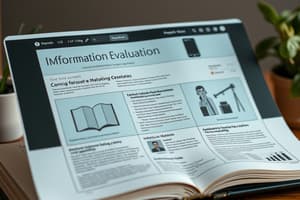Podcast
Questions and Answers
What is the main function of ATP in living organisms?
What is the main function of ATP in living organisms?
- To aid in cell division
- To regulate body temperature
- To provide energy for cellular activities (correct)
- To store genetic information
Which molecule is ATP composed of?
Which molecule is ATP composed of?
- Adenosine and three inorganic phosphates (correct)
- Adenosine and four inorganic phosphates
- Adenosine and five inorganic phosphates
- Adenosine and two inorganic phosphates
What is the specific role of ATP in linking exergonic and endergonic reactions?
What is the specific role of ATP in linking exergonic and endergonic reactions?
- To provide the necessary energy for the endergonic reactions (correct)
- To prevent both types of reactions
- To inhibit both types of reactions
- To slow down both types of reactions
Which of the following best describes an endergonic reaction?
Which of the following best describes an endergonic reaction?
What is the function of ADP in the ATP-ADP cycle?
What is the function of ADP in the ATP-ADP cycle?
What is the primary source of energy used by living organisms?
What is the primary source of energy used by living organisms?
What is the most important role of ADP in living cells?
What is the most important role of ADP in living cells?
What is the process by which organisms use oxygen to turn fuel into chemical energy?
What is the process by which organisms use oxygen to turn fuel into chemical energy?
What is the product of respiration that is often referred to as the 'currency' of the cell?
What is the product of respiration that is often referred to as the 'currency' of the cell?
What type of respiration can break down sugars to generate energy in the absence of oxygen?
What type of respiration can break down sugars to generate energy in the absence of oxygen?
What is the energy required for endergonic reactions called?
What is the energy required for endergonic reactions called?
What is the process of combining ADP with a phosphate molecule to make ATP called?
What is the process of combining ADP with a phosphate molecule to make ATP called?
Where does the energy released from breaking a molecular bond in ATP come from?
Where does the energy released from breaking a molecular bond in ATP come from?
What provides the premier energy molecule in living cells?
What provides the premier energy molecule in living cells?
Flashcards are hidden until you start studying
Study Notes
ATP and Energy Metabolism
- ATP (Adenosine Triphosphate) is the primary energy currency of the cell, providing energy for various cellular processes.
- ATP is composed of adenine, a five-carbon sugar (ribose), and three phosphate groups.
ATP-ADP Cycle and Energy Transfer
- ATP plays a crucial role in linking exergonic (energy-releasing) and endergonic (energy-requiring) reactions, allowing energy to be transferred between them.
- During exergonic reactions, ATP is generated, and during endergonic reactions, ATP is broken down to ADP (Adenosine Diphosphate).
ADP and Energy Metabolism
- ADP is the primary recipient of energy from the breakdown of ATP, allowing it to be recycled back into ATP.
- The primary role of ADP is to accept energy from the breakdown of ATP, which can then be used to drive endergonic reactions.
Cellular Respiration and Energy Production
- The primary source of energy used by living organisms is the breakdown of glucose and other nutrients through cellular respiration.
- Cellular respiration is the process by which organisms use oxygen to turn fuel into chemical energy, producing ATP as a byproduct.
Types of Respiration and Energy Production
- Anaerobic respiration is a type of respiration that can break down sugars to generate energy in the absence of oxygen.
- The energy required for endergonic reactions is called activation energy.
ATP Synthesis and Phosphorylation
- The process of combining ADP with a phosphate molecule to make ATP is called phosphorylation.
- The energy released from breaking a molecular bond in ATP comes from the energy stored in the phosphate bonds.
- ATP provides the premier energy molecule in living cells, powering various cellular processes.
Studying That Suits You
Use AI to generate personalized quizzes and flashcards to suit your learning preferences.




